《近代中国对外关系史 The History of Modern China's Foreign Relations》课程教学资源(PPT讲稿)Week 2 - The Collision of the Chinese and British Empires, 1792-1816
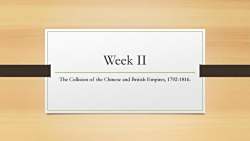
Week II The Collision of the Chinese and British Empires,1792-1816
Week II The Collision of the Chinese and British Empires, 1792-1816

Empire of the Great Qing 25th Year of the Jiaqing Emperor (A.D.1820) R Boundaries and Provinces of Qing China,1820 ----Boundaries and claims of Modern China KOBDO U BUKHARA ULIASSUTAI OUTER MONGOLIA XI N J IA N G MO SOUTHERN SEA INNER KOREA GREAT QINGHAI HAND EASTERN ENA SICHUAN GREAT SOUTHERN OCEAN IANGX HUNAN GUIZHOU N BENGAL (British Fast india Co.) YUNNAN GUANGX BURMA ANNAM SOUTHERN SEA LUANG PRABANG PH ILIPPINES SIAM (SPAIN)
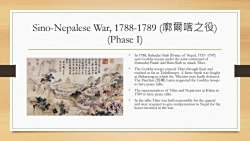
Sino-Nepalese War,1788-1789(廓爾喀之役) (Phase I) In 1788,Bahadur Shah (Prince of Nepal,1757-1797) sent Gorkha troops under the joint command of 田6月 Damodar Pande and Bam Shah to attack Tibet. The Gorkha troops entered Tibet through Kuti and reached as far as Tashilhunpo.A fierce battle was fought at Shikarjong in which the Tibetans were badly defeated. The Panchen)Lama requested the Gorkha troops to have peace talks. The representatives of Tibet and Nepal met at Khiru in 1789 to have peace talks. In the talks Tibet was held responsible for the quarrel and were required to give compensation to Nepal for the losses incurred in the war
Sino-Nepalese War, 1788-1789 (廓爾喀之役) (Phase I) • In 1788, Bahadur Shah (Prince of Nepal, 1757- 1797) sent Gorkha troops under the joint command of Damodar Pande and Bam Shah to attack Tibet. • The Gorkha troops entered Tibet through Kuti and reached as far as Tashilhunpo. A fierce battle was fought at Shikarjong in which the Tibetans were badly defeated. The Panchen (班禅) Lama requested the Gorkha troops to have peace talks. • The representatives of Tibet and Nepal met at Khiru in 1789 to have peace talks. • In the talks Tibet was held responsible for the quarrel and were required to give compensation to Nepal for the losses incurred in the war
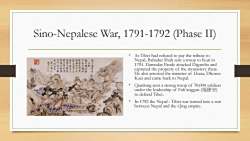
Sino-Nepalese War,1791-1792 Phase ID) As Tibet had refused to pay the tribute to Nepal,Bahadur Shah sent a troop to Kuti in 不 通 云间 政克 1791.Damodar Pande attacked Digarcha and captured the property of the monastery there. 5 He also arrested the minister of Lhasa,Dhoren Kazi and came back to Nepal. Qianlong sent a strong troop of 70,000 soldiers under the leadership of Fuk'anggan(福康安) to defend Tibet. In 1792 the Nepal-Tibet war turned into a war between Nepal and the Qing empire
Sino-Nepalese War, 1791-1792 (Phase II) • As Tibet had refused to pay the tribute to Nepal, Bahadur Shah sent a troop to Kuti in 1791. Damodar Pande attacked Digarcha and captured the property of the monastery there. He also arrested the minister of Lhasa, Dhoren Kazi and came back to Nepal. • Qianlong sent a strong troop of 70,000 soldiers under the leadership of Fuk‘anggan (福康安) to defend Tibet. • In 1792 the Nepal - Tibet war turned into a war between Nepal and the Qing empire
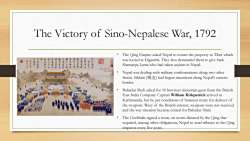
The Victory of Sino-Nepalese War,1792 The Qing Empire asked Nepal to return the property to Tibet which was looted at Digarcha.They also demanded them to give back Shamarpa Lama who had taken asylum in Nepal. Nepal was dealing with military confrontations along two other fronts.Sikkim (had begun incursions along Nepal's eastern border. Bahadur Shah asked for 10 howitzer mountain guns from the British East India Company.Captain William Kirkpatrick arrived in Kathmandu,but he put conditions of business treaty for delivery of the weapons.Wary of the British interest,weapons were not received and the war situation became critical for Bahadur Shah. The Gorkhalis signed a treaty on terms dictated by the Qing that required,among other obligations,Nepal to send tributes to the Qing emperor every five vears
The Victory of Sino-Nepalese War, 1792 • The Qing Empire asked Nepal to return the property to Tibet which was looted at Digarcha. They also demanded them to give back Shamarpa Lama who had taken asylum in Nepal. • Nepal was dealing with military confrontations along two other fronts. Sikkim (锡金) had begun incursions along Nepal's eastern border. • Bahadur Shah asked for 10 howitzer mountain guns from the British East India Company. Captain William Kirkpatrick arrived in Kathmandu, but he put conditions of business treaty for delivery of the weapons. Wary of the British interest, weapons were not received and the war situation became critical for Bahadur Shah. • The Gorkhalis signed a treaty on terms dictated by the Qing that required, among other obligations, Nepal to send tributes to the Qing emperor every five years
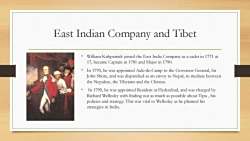
East Indian Company and Tibet William Kirkpatrick joined the East India Company as a cadet in 1771 at 17,became Captain in 1781 and Major in 1790. .In 1793,he was appointed Aide-de-Camp to the Governor General,Sir John Shore,and was dispatched as an envoy to Nepal,to mediate between the Nepalese,the Tibetans and the Chinese. In 1795,he was appointed Resident at Hyderabad,and was charged by Richard Wellesley with finding out as much as possible about Tipu,his policies and strategy.This was vital to Wellesley as he planned his strategies in India
East Indian Company and Tibet • William Kirkpatrick joined the East India Company as a cadet in 1771 at 17, became Captain in 1781 and Major in 1790. • In 1793, he was appointed Aide-de-Camp to the Governor General, Sir John Shore, and was dispatched as an envoy to Nepal, to mediate between the Nepalese, the Tibetans and the Chinese. • In 1795, he was appointed Resident at Hyderabad, and was charged by Richard Wellesley with finding out as much as possible about Tipu , his policies and strategy. This was vital to Wellesley as he planned his strategies in India
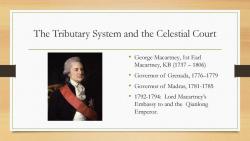
The Tributary System and the Celestial Court George Macartney,1st Earl Macartney,KB(1737-1806) Governor of Grenada,1776-1779 Governor of Madras,1781-1785 .1792-1794:Lord Macartney's Embassy to and the Qianlong Emperor
The Tributary System and the Celestial Court • George Macartney, 1st Earl Macartney, KB (1737 – 1806) • Governor of Grenada, 1776–1779 • Governor of Madras, 1781-1785 • 1792-1794: Lord Macartney ’s Embassy to and the Qianlong Emperor
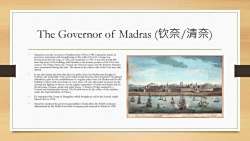
The Governor of Madras(钦奈/请奈) Macarmey was the Governor of Madras from 1781 to 1785.During his tenure as govemor,renovation and strengthening of the walls of Fort St.George was commenced after the siege of lally and completed in 1783.It was also during this time that most of the buildings and barracks in the western portion of the Fort were erected.The Palace Street,the Arsenal,the Hanover square and the Western Barracks were constructed during this time.The streets in the eastern side of the Fort were also altered. It was also during this time that idea of a police force for Madras was thought of. Popham,the brainchild of the street which would bear his name (Popham's Broadway) submitted a plan for the establishment of a regular police force for Madras and for the building of direct and cross drains in every street.He also advocated measures for the naming and lighting of streets,for the regular registration of births and deaths and for the licensing of lquor,arrack and toddy shops.A Board of Police assisted by a Kotwal was subsequently formed.The Kotwal was to be the officer of the markets under the Superintendent of Police. He negotiated the Treary of Mangalore which brought an end to the Second Anglo- Mysore War in 1784. Macartney declined the govemnor-generalship of India (then the British terrirories administered by the Britsh East India Company)and returned to Britain in 1786
The Governor of Madras (钦奈/清奈) • Macartney was the Governor of Madras from 1781 to 1785. During his tenure as governor, renovation and strengthening of the walls of Fort St. George was commenced after the siege of Lally and completed in 1783. It was also during this time that most of the buildings and barracks in the western portion of the Fort were erected. The Palace Street, the Arsenal, the Hanover square and the Western Barracks were constructed during this time. The streets in the eastern side of the Fort were also altered. • It was also during this time that idea of a police force for Madras was thought of. Popham, the brainchild of the street which would bear his name (Popham's Broadway) submitted a plan for the establishment of a regular police force for Madras and for the building of direct and cross drains in every street. He also advocated measures for the naming and lighting of streets, for the regular registration of births and deaths and for the licensing of liquor, arrack and toddy shops. A Board of Police assisted by a Kotwal was subsequently formed. The Kotwal was to be the officer of the markets under the Superintendent of Police.[ • He negotiated the Treaty of Mangalore which brought an end to the Second Anglo- Mysore War in 1784. • Macartney declined the governor-generalship of India (then the British territories administered by the British East India Company) and returned to Britain in 1786
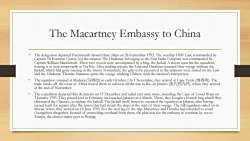
The Macartney Embassy to China The delegation departed Portsmouth aboard three ships on 26 September 1792.The warship HM.S Liom,commanded by Captain Sir Erasmus Gower,led the mission.The Hindostam,belonging to the East India Company was commanded by Captain William Mackintosh.These two vessels were accompanied by a brig,the Jackall A storm soon hit the squadron, forcing it to stop temporarily at Tor Bay.After making repairs,the Liom and Hindortan resumed their voyage without the Jackall,which had gone missing in the storm.Fortunately,the gifts to be presented to the emperor were stored on the Liom and the Hindostan.Thomas Staunton spent the voyage studying Chinese with the mission's interpreters The squadron stopped at Madeira(马得)in early October..On 1 November,,they arrived at Cape Verde(维得角).The trade winds off the coast of Africa forced them to sail west all the way to Rio de Janeiro(里约热内,where they arrived at the end of November. The expedition departed Rio de Janeiro on 17 December and sailed east once more,rounding the Cape of Good Hope on 7 January 1793.They passed Java in February,and reached Jakarta on 6 March.There,they bought a French brig which they christened the Clarence,to replace the Jackall.The Jackall itself,however,rejoined the squadron at Jakarta,after having turned back for repairs after the storm that had struck the ships at the start of their voyage.The full squadron sailed on to Macau,where they arrived on 19 June 1793.For the next leg of the trip,Macartney and Dundas had intended to avoid Guangzhou altogether.Instead of proceeding overland from there,the plan was for the embassy to continue by sea to Tianjin,the closest major port to Beijing
The Macartney Embassy to China • The delegation departed Portsmouth aboard three ships on 26 September 1792. The warship HMS Lion, commanded by Captain Sir Erasmus Gower, led the mission.The Hindostan, belonging to the East India Company was commanded by Captain William Mackintosh. These two vessels were accompanied by a brig, the Jackall. A storm soon hit the squadron, forcing it to stop temporarily at Tor Bay. After making repairs, the Lion and Hindostan resumed their voyage without the Jackall, which had gone missing in the storm. Fortunately, the gifts to be presented to the emperor were stored on the Lion and the Hindostan. Thomas Staunton spent the voyage studying Chinese with the mission’s interpreters. • The squadron stopped at Madeira (马得拉) in early October. On 1 November, they arrived at Cape Verde (维得角). The trade winds off the coast of Africa forced them to sail west all the way to Rio de Janeiro (里约热内庐), where they arrived at the end of November. • The expedition departed Rio de Janeiro on 17 December and sailed east once more, rounding the Cape of Good Hope on 7 January 1793. They passed Java in February, and reached Jakarta on 6 March. There, they bought a French brig which they christened the Clarence, to replace the Jackall. The Jackall itself, however, rejoined the squadron at Jakarta, after having turned back for repairs after the storm that had struck the ships at the start of their voyage. The full squadron sailed on to Macau, where they arrived on 19 June 1793. For the next leg of the trip, Macartney and Dundas had intended to avoid Guangzhou altogether. Instead of proceeding overland from there, the plan was for the embassy to continue by sea to Tianjin, the closest major port to Beijing
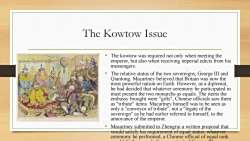
The Kowtow Issue The kowtow was required not only when meeting the emperor,but also when receiving imperial edicts from his messengers. The relative status of the two sovereigns,George III and Qianlong.Macartney believed that Britain was now the most powerful nation on Earth.However,as a diplomat, he had decided that whatever ceremony he participated in must present the two monarchs as equals.The items the embassy brought were "gifts",Chinese officials saw them as "tribute"items.Macartney himself was to be seen as only a "conveyor of tribute",not a "legate of the sovereign"as he had earlier referred to himself,to the annoyance of the emperor. Macartney submitted to Zhengrui a written proposal that would satisfy his requirement of equal status:whatever ceremony he performed,a Chinese official of equal rank
The Kowtow Issue • The kowtow was required not only when meeting the emperor, but also when receiving imperial edicts from his messengers. • The relative status of the two sovereigns, George III and Qianlong. Macartney believed that Britain was now the most powerful nation on Earth. However, as a diplomat, he had decided that whatever ceremony he participated in must present the two monarchs as equals. The items the embassy brought were "gifts" , Chinese officials saw them as "tribute" items. Macartney himself was to be seen as only a "conveyor of tribute" , not a "legate of the sovereign" as he had earlier referred to himself, to the annoyance of the emperor. • Macartney submitted to Zhengrui a written proposal that would satisfy his requirement of equal status: whatever ceremony he performed, a Chinese official of equal rank would do the same before a portrait of George III
按次数下载不扣除下载券;
注册用户24小时内重复下载只扣除一次;
顺序:VIP每日次数-->可用次数-->下载券;
- 《近代中国对外关系史 The History of Modern China's Foreign Relations》课程教学资源(PPT讲稿)Week 16 - The Collapse of the Nationalist Government.pptx
- 《近代中国对外关系史 The History of Modern China's Foreign Relations》课程教学资源(PPT讲稿)Week 15 - The Pacific War, 1941-1945.pptx
- 《近代中国对外关系史 The History of Modern China's Foreign Relations》课程教学资源(PPT讲稿)Week 14 - The Second Sino-Japanese War, 1937-1941.pptx
- 《近代中国对外关系史 The History of Modern China's Foreign Relations》课程教学资源(PPT讲稿)Week 13 - The Nanjing Decade and the New Era of China's Diplomacy.pptx
- 《近代中国对外关系史 The History of Modern China's Foreign Relations》课程教学资源(PPT讲稿)Week 12 - The South Revolutionaries' Nationalistic Claims and Anti-Imperialistic Campaigns.pptx
- 《近代中国对外关系史 The History of Modern China's Foreign Relations》课程教学资源(PPT讲稿)Week 11 - China's Participation into the Global Order.pptx
- 《近代中国对外关系史 The History of Modern China's Foreign Relations》课程教学资源(PPT讲稿)Week 10 - The Early Republic's Diplomatic Difficulties.pptx
- 《近代中国对外关系史 The History of Modern China's Foreign Relations》课程教学资源(PPT讲稿)Week 1 - Introduction.pptx
- 《近代中国对外关系史 The History of Modern China's Foreign Relations》课程教学资源(PPT讲稿)What’s the Battle of Shanghai:new trial to research Sino- Japanese War by GIS.pptx
- 《中国近代史专题研究》课程教学资源(团练、水师与军阀)教学大纲 Research Topics on Modern Chinese History Militia, Navy and Warlordism.docx
- 《中国近代史专题研究》课程教学资源(团练、水师与军阀)第8周 袁氏四年、強人政治(中华民国北洋时期:北洋军阀之起源、袁世凯和洪宪帝制).pptx
- 《中国近代史专题研究》课程教学资源(团练、水师与军阀)第9周 府院之爭,張勳復辟(中华民国北洋时期:两次府院之争、北洋之虎、和南北战争).pptx
- 《中国近代史专题研究》课程教学资源(团练、水师与军阀)第7周 新建陸軍與袁世凱的崛起(北洋新軍與袁世凱).pptx
- 《中国近代史专题研究》课程教学资源(团练、水师与军阀)第6周 八國聯軍和武衛軍覆滅.pptx
- 《中国近代史专题研究》课程教学资源(团练、水师与军阀)第5周 甲午戰爭和淮軍覆滅.pptx
- 《中国近代史专题研究》课程教学资源(团练、水师与军阀)第4周 捻亂、回變與團練勢力的擴大 The Muslim Uprising and the Nian Bandits.pptx
- 《中国近代史专题研究》课程教学资源(团练、水师与军阀)第3周 團練的興起與太平天國的覆滅.pptx
- 《中国近代史专题研究》课程教学资源(团练、水师与军阀)第2周 綠營的覆滅與太平天國的興起 THE TAIPING HEAVENLY KINGDOM AND CENTRAL TROOPS OF THE QING EMPIRE.pptx
- 《中国近代史专题研究》课程教学资源(团练、水师与军阀)第1周 導言 Introduction.pptx
- 《中国近代史专题研究》课程教学资源(团练、水师与军阀)第15周 安國軍與天下三分(第一次北伐、寧漢分裂、第二次北伐).pptx
- 《近代中国对外关系史 The History of Modern China's Foreign Relations》课程教学资源(PPT讲稿)Week 3 - The First Opium War and the Treaty of Nanking.pptx
- 《近代中国对外关系史 The History of Modern China's Foreign Relations》课程教学资源(PPT讲稿)Week 4 - The Second Opium War and the Reconfirmation of the Treaty System.pptx
- 《近代中国对外关系史 The History of Modern China's Foreign Relations》课程教学资源(PPT讲稿)Week 5 - The Self Strengthening Movement and the CMCS, 1861-1885.pptx
- 《近代中国对外关系史 The History of Modern China's Foreign Relations》课程教学资源(PPT讲稿)Week 6 - Tributary States and the Sino-Foreign Conflicts.pptx
- 《近代中国对外关系史 The History of Modern China's Foreign Relations》课程教学资源(PPT讲稿)Week 7 - The Partition of China and the Hundred Days' Reforms.pptx
- 《近代中国对外关系史 The History of Modern China's Foreign Relations》课程教学资源(PPT讲稿)Week 8 - The Boxer War and the International Protocol.pptx
- 《近代中国对外关系史 The History of Modern China's Foreign Relations》课程教学资源(PPT讲稿)Week 9 - The New Policies Reforms and the Anglo-Japanese Alliance.pptx
- 《近代中国对外关系史 The History of Modern China's Foreign Relations》课程教学资源(阅读材料)Anglo-Chinese Diplomacy in the Sir John Jordan and Yuan Shih-k'ai(1906-1920).pdf
- 《近代中国对外关系史 The History of Modern China's Foreign Relations》课程教学资源(阅读材料)Anglo-Chinese Diplomacy in the Sir John Jordan and Yuan Shih-k'ai(1906-1920).pdf
- 《近代中国对外关系史 The History of Modern China's Foreign Relations》课程教学资源(阅读材料)Revisiting the Chinese Maritime Customs Service, 1854 –1950.pdf
- 《近代中国对外关系史 The History of Modern China's Foreign Relations》课程教学资源(阅读材料)Cambridge History of China Vol. 11 Ch 4 THE MILITARY CHALLENGE(THE NORTH-WEST AND THE COAST).pdf
- 《近代中国对外关系史 The History of Modern China's Foreign Relations》课程教学资源(阅读材料)China in Revolution(he First Phase,1900-1913).pdf
- 《近代中国对外关系史 The History of Modern China's Foreign Relations》课程教学资源(阅读材料)China's Struggle for Naval Development 1839-1895.pdf
- 《近代中国对外关系史 The History of Modern China's Foreign Relations》课程教学资源(阅读材料)SIR FREDERICK MAZE AND THE CHINESE hIARITIME CUSTOMS, 1937-1941.pdf
- 《近代中国对外关系史 The History of Modern China's Foreign Relations》课程教学资源(阅读材料)Embarrassed Monarchist:Frank J. Goodnow and Constitutional Development in China, 1913-1915.pdf
- 《近代中国对外关系史 The History of Modern China's Foreign Relations》课程教学资源(阅读材料)Fairbank, China New History(China's War of Resistance 1937-1945).pdf
- 《近代中国对外关系史 The History of Modern China's Foreign Relations》课程教学资源(阅读材料)Foreign Devils, Finance and Informal Empire:Britain and China c.1900–1912.pdf
- 《近代中国对外关系史 The History of Modern China's Foreign Relations》课程教学资源(阅读材料)Foreign-Training and China's Self-Strengthening(The Case of Feng-huang-shan, 1864——1873).pdf
- 《近代中国对外关系史 The History of Modern China's Foreign Relations》课程教学资源(阅读材料)晚清的幕府制度(Friends, Guests, and Colleagues).pdf
- 《近代中国对外关系史 The History of Modern China's Foreign Relations》课程教学资源(阅读材料)God's Chinese Son(THE SPLIT).pdf
